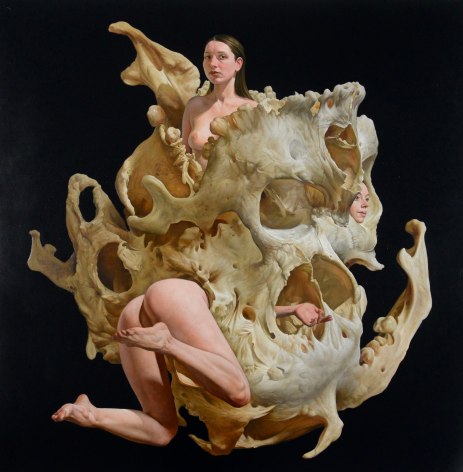
Erik Thor Sandberg
Castle, 2023
oil on wood panel
36h x 36w in
ES108
CONNERSMITH is pleased to announce an exhibition of new paintings by American surrealist Erik Thor Sandberg. In his latest corpus, STRANGE ATTRACTORS, Sandberg sets forth unique visions of individuals and societies as complex spheres revolving in space. Interwoven human and animal forms inhabit these distinct worlds, embedded in various cohering elements of bone, water, earth, and wood. Within each system, the artist builds narratives around disparate members that function as a singular organism. Some figures exude a sense of stability, peacefulness, or triumph. Others, at odds with their circumstances, move in divergent directions, struggling to redirect the revolving constructs, or destroy the barriers that separate them.
“Each of these paintings exists as its own world. The setting is purposefully nebulous to suggest a closed environment without external factors beyond light and gravity. The figures live in isolation, as on separate planets. But what happens if they interact?” - ERIK THOR SANBERG
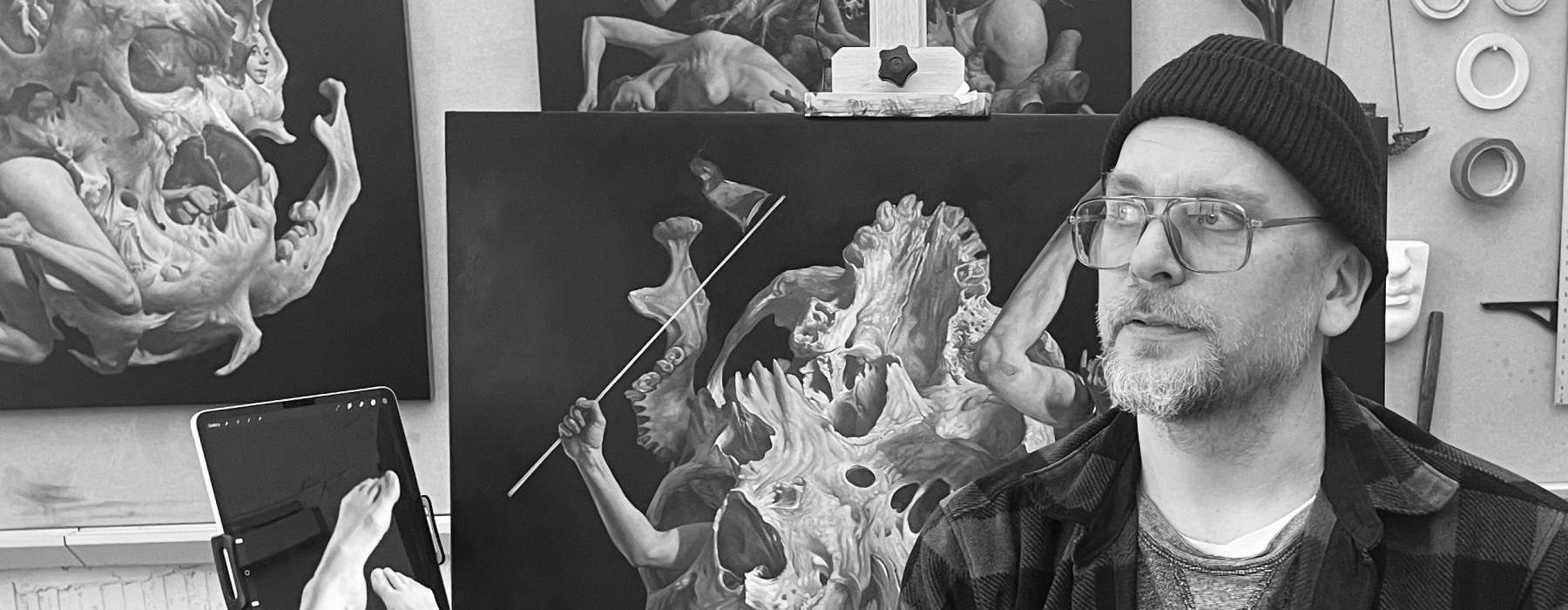
Erik Thor Sandberg, December 2023 (scroll for interview)
Q + A with Erik Thor Sandberg and Jamie L. Smith, Ph.D. (January 2024)
JS: Erik, I have had the privilege of studying your art over the past two decades, and I find more fascinating discoveries with each body of work. So, I am excited to explore these new works with you. Let’s begin with a few insights into your art and practice. Then we will delve into the specific works in this new series. First, what do you find most gratifying about being an artist? What motivates you?
ETS: I love creating little worlds; I can make my own rules for new universes; It’s a nice way to express myself. I’m from Finnish stock; we are not demonstrative people. I am the most emotionally expressive member of my family. These worlds give me an enjoyable outlet.
JS: You worked on this cycle of paintings for a year, spending two to three months on each panel, making hundreds of decisions along the way. How do you know when you have achieved what you want in painting a work?
ETS: It’s about the fulfillment of the narrative coming together in each painting and it’s about the images looking right to me – when the relationships between the figures, and colors, just click. The fun part is telling a story, realizing that the image is communicating what I am trying to express. Communication is so important in life. I think we all strive for that connection.
JS: For the most part, you paint nude figures. Why?
ETS: I want a timeless feel to my paintings. I want to express ideas about our relationships to one another and to our world. And I like to paint flesh. I don’t want clothing to be a prominent feature. Trendy clothing can make a work look dated within a few years. I collect distinctive objects and vintage clothing; my studio is full of these things. When I integrate them into my works, I tend to cull them from various time periods.
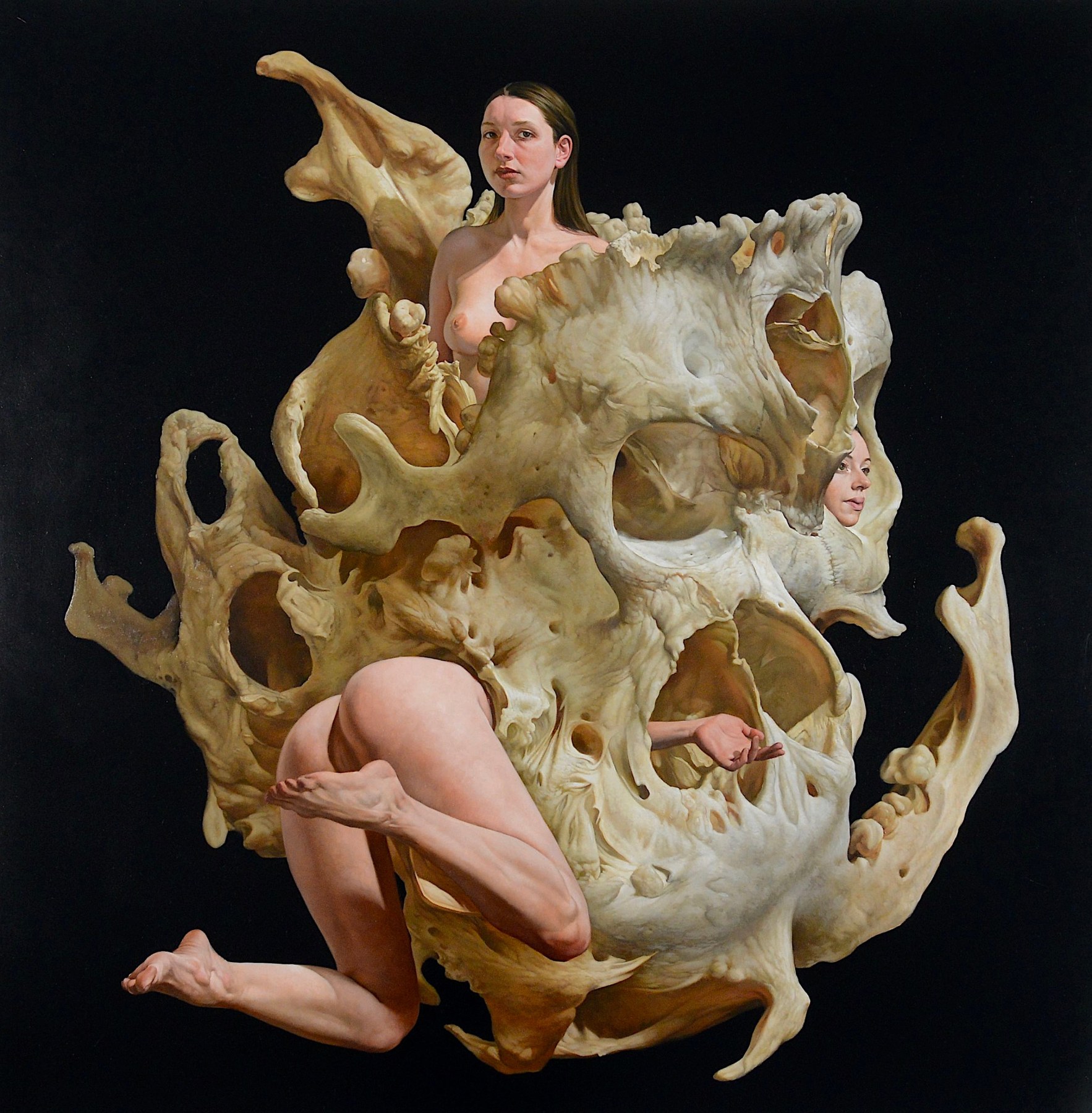
Erik Thor Sandberg - Castle, scroll for details.
JS: Give us some insight into how you construct meaning in your works.
ETS: I have a set of ideas in mind at the outset, but I also like my imagery to prompt discoveries. When people are open to the works, the paintings continue to generate ideas after I complete them. I always start with a feeling. CASTLE began with a sense of peacefulness and stability. Three figures are at peace within this form, a vessel, a head that contains thoughts as in someone’s mind. Each figure is in her own cavernous space. They are protected, maybe from what’s outside, or maybe from each other. The figure at the top is surrounded by teeth that look like ramparts of a castle. I rarely depict figures staring directly at the viewer. It’s more of a portrait. She is confident and all three figures are serene. They are as one; they are in harmony.
JS: Your work is often likened to Old Master paintings for obvious material and formal reasons. What affinity do you have with earlier traditions?
ETS: I sometimes look at older works for inspiration. I initially conceived these jumbles of figures with empty space around them based on a copy of Leonardo da Vinci's Battle of Anghiari. Hands wielding axes, and other implements, recall da Vinci’s weaponry. But in my work, they are symbolic rather than historic. My figures are at odds with their circumstances, they move in disparate directions, struggling to stop or redirect the revolving construct that confines them.
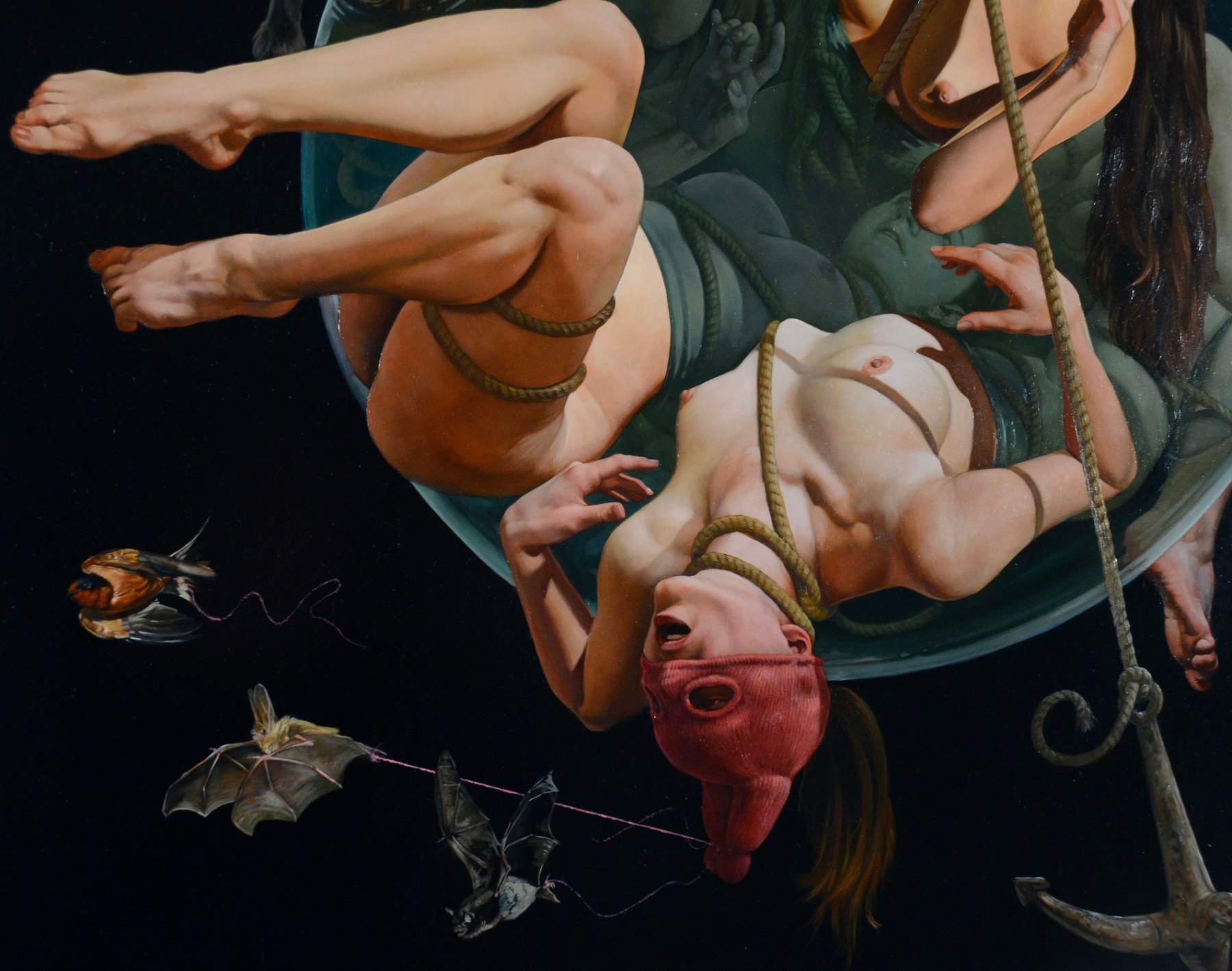
Erik Thor Sandberg, Course Correction (detail), scroll for details.
JS: As we see in COURSE CORRECTION?
ETS: Yes. I was thinking of Ship of Fools paintings by Bosch and Cranach, with farcical, silly characters. Mine are all trying to get away from each other, but the rope binds them together. If they worked in unison, they could meet some goal. The swallow attached to a hat thread, and the bats, are all pulling in the same direction, but the swallow gets away. The bats, goat, and skull recall Goya’s witches. The figure holding purse is trying to keep something of value safe, we don’t see her head. The figure with the anchor is hoping to stay in place, unlike the rest, but it is an anchor without any purchase. She looks in the direction they are moving but has no control.
JS: The figures in this group are very diverse.
ETS: This is the most diverse group of individuals I painted in the series. It represents the world in general.
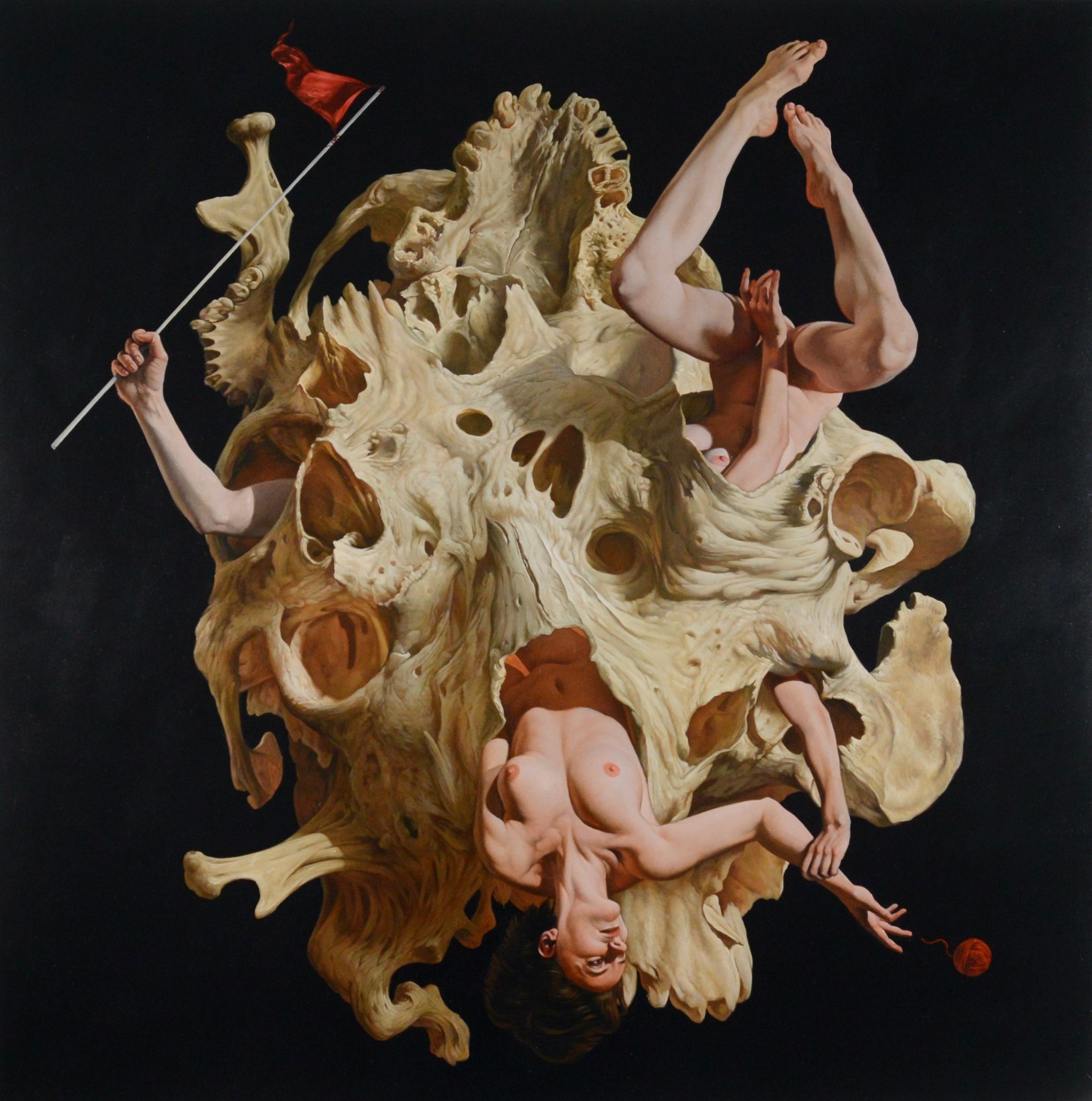
Erik Thor Sandberg, Claim - scroll for details.
JS: What makes your work contemporary?
ETS: There are no new emotions or basic ideas in art; there have been scientific advances, but people are still basically the same. What makes my work contemporary is that I am interpreting the world that we live in today. For example, CLAIM is about autonomy over one’s mind and body. It features bones from the hip, pelvis, and skull. It’s about losing rights over our bodies, with the repeal of Roe v. Wade, and our intellects, through book banning. I wanted to create a work about claiming personal autonomy. The hand with the flag is trying to stake a claim. The hand dropping the yarn evokes defiance. Pussy hats were knit as a sign of protest for women’s rights and symbolism of women knitting in defiance goes back to A Tale of Two Cities. Or it can also be understood as a sign that someone is expecting a child, like knitting booties. The hand grabbing her arm has effectively taken away either option.
JS: You used various cohering elements – bone, wood, earth, and water - within each discrete system. How does the nature of each material affect the relationships between the figures?
ETS: Inside the spheres of water, the figures are more joined. Water, in its depths, suggests the unknown. But it is also a source for life, which can be connective, even placental. The watery sphere in COURSE CORRECTION suggests adaptability, whereas within the bone substrate of CASTLE, the figures are cut off, not interacting. In THICKET, the figures are interwoven like branches. There is some interaction, but the roots and earth solidify the positions of the figures, so the trees act as walls that divide them. I wanted an organic element with figures hidden in it. But they all want to get out. Their world is not at peace. They are trying to chop or burn it to get free. An eagle eye is looking out from the interior; the space is opaque and unknown; we can’t see inside, in contrast to CLAIM which glows from within. The owls represent surveillance and judgment. With human-like masks around their eyes, they possess human-like knowledge. They are something to be wary of, they are watching.
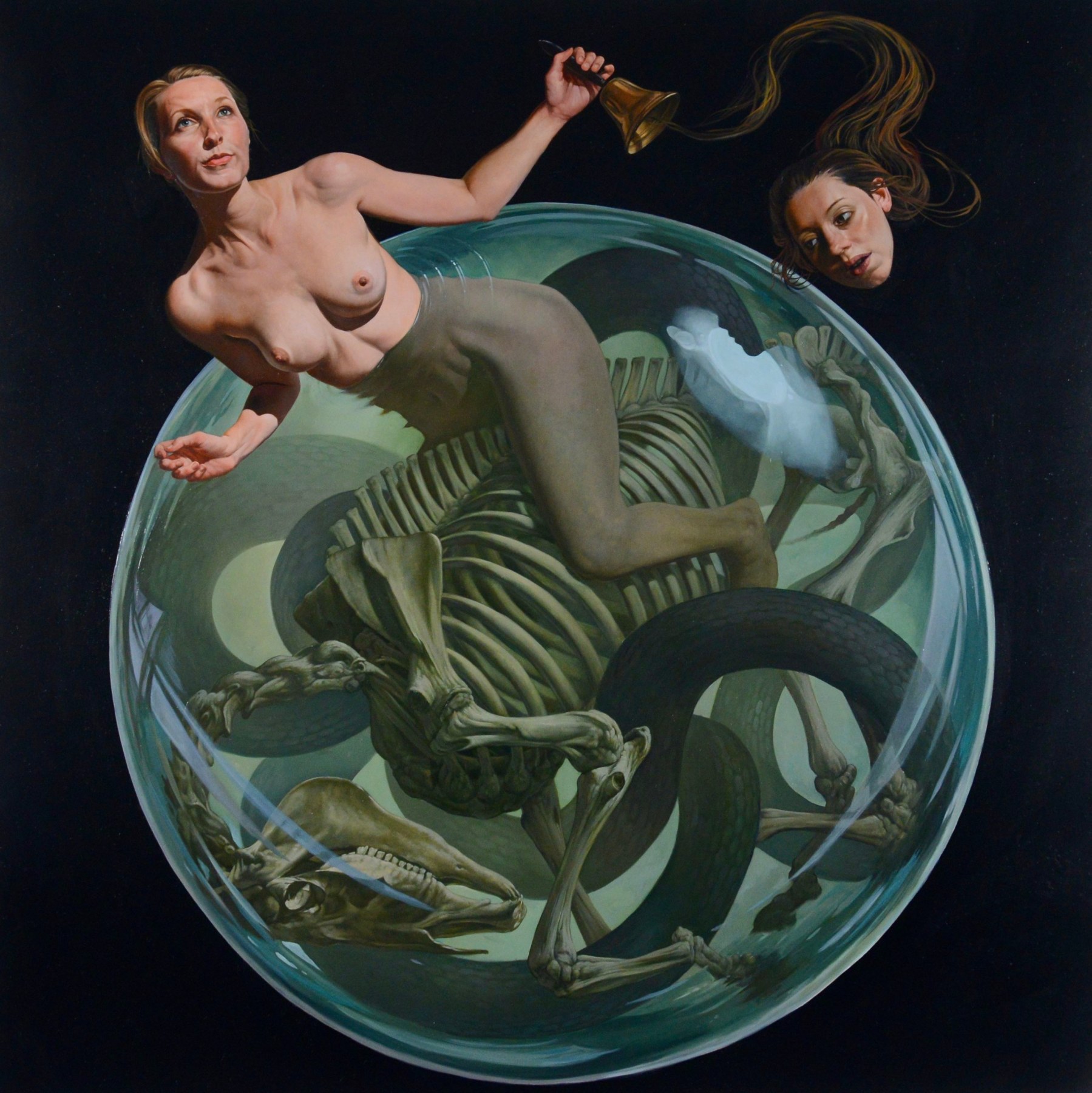
Erik Thor Sandberg, Peal - scroll for details.
JS: That sounds mysterious! As does the title of this series, STRANGE ATTRACTORS. The term comes from a theory that consciousness exists as a quantum wave which connects with the universe. In other words, two particles that are very far away may be connected because they are both moving along the same trajectory. Would you say this concept is most relevant to your narrative in PEAL?
ETS: Yes. Each of these paintings exists as its own world; the setting is purposefully nebulous to suggest a closed environment without external factors beyond light and gravity. The figures live in isolation, as on separate planets. But what happens if they interact? In PEAL, the main figure is ringing a bell, calling out to others. She is signaling an emotion, she is happy, perhaps even triumphant. The disembodied head issuing from the bell represents the others and functions as a witness to her message. In the watery sphere, a serpent is swimming. With no head or tail visible, it has no beginning or end. It represents time passing, and maybe danger lurking. The horse is a mere skeleton, but it is still trying to run. The seraphim-like head is the seat of consciousness; she does not need a body to be a witness. Her expression suggests that she is in awe, or perhaps about to speak. Either way, something is coming, some kind of change is about to occur.
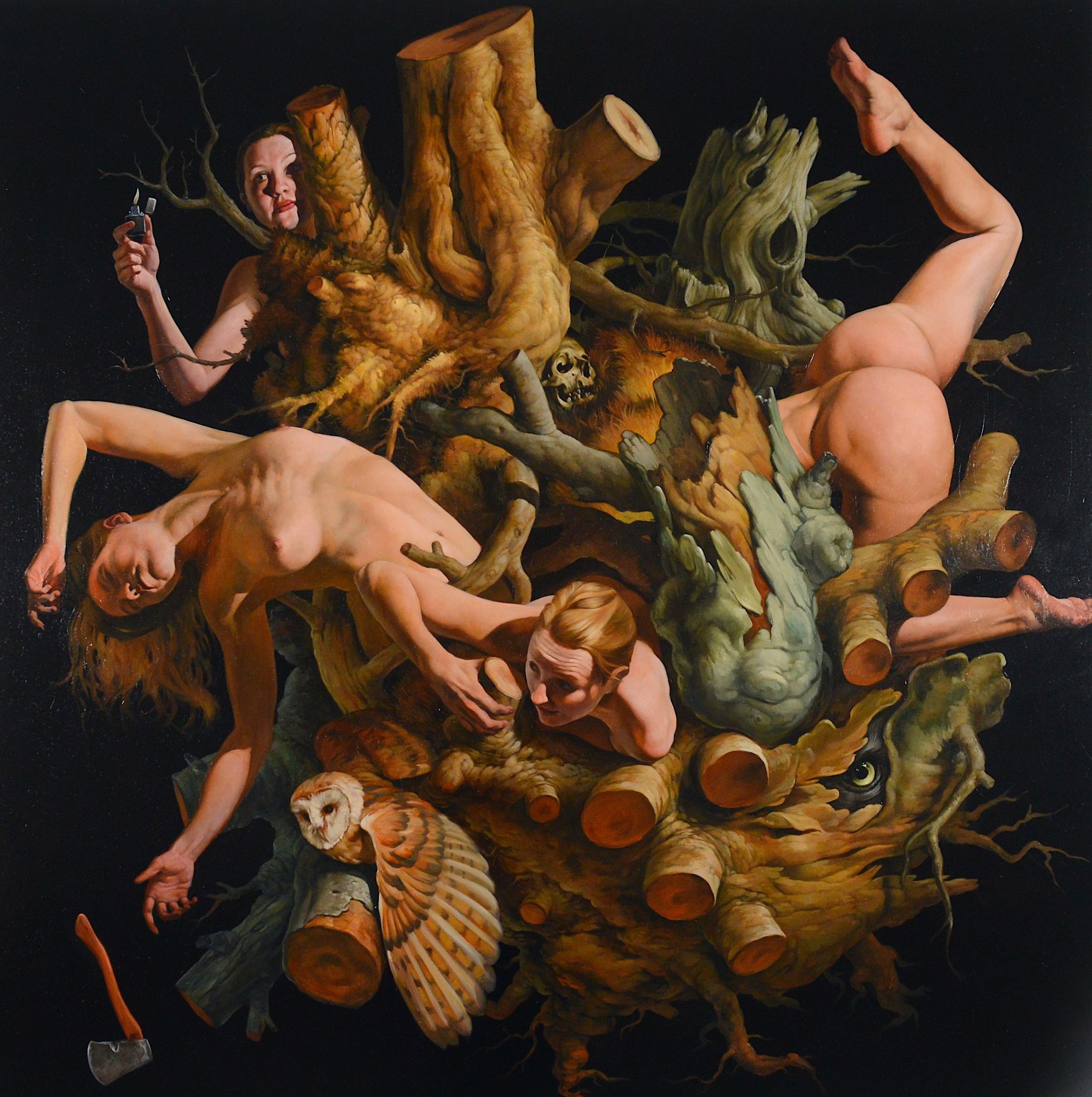
Erik Thor Sandberg, Thicket - scroll for details.
JS: How suspenseful…change is coming. Regarding change, one thing you sometimes change across bodies of work is the size of your panels. Let’s conclude by discussing your use of scale. Here, we are considering, not only physical dimensions, but what I understand as ontological and psychological dimensions as well. When painting smaller panels, you tend to work entirely from your imagination, whereas for larger paintings, you work with live models. Would you elaborate on those two modes of working?
ETS: Dürer often engraved small-scale imagery from his imagination, fantastic stuff that couldn’t have been based directly on nature. My small-scale compositions are also straight out of my head. I let myself get more carried away in bending reality when I paint them. They appear looser in style, more cartoon like. The small paintings are more storybook, like action-figure play sets that I imagine. I can use everything in my brain’s toy bin to create them. When I work in medium scale, like in this new series, I feel that anatomy should look really accurate, so I use live models in choreographed poses. The imagery becomes more real, more serious for me. In that scale, I am further externalizing my inner world. That feels like a much bigger commitment. Details are more important, so my painting is more technical.
JS: And you paint in even larger scale at times.
ETS: Yes. In my much larger-scale works, six or eight feet tall, it becomes more about the movement of my own body as I paint. I may return to that larger scale in the future.

CONNERSMITH. installation view January 2024.